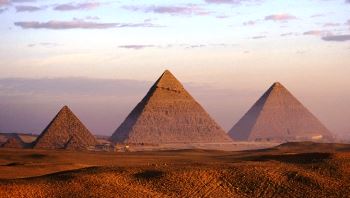|
Mysterious 'space' in Great Pyramid revealed by cosmic ray Camera
by Belinda Smith via zed - ABC (Oz) Thursday, Nov 2 2017, 11:48pm
international /
prose /
post
A cosmic camera that uses high-energy particles from outer space to see through stone has given us a tantalising glimpse of an undiscovered space in the Great Pyramid of Giza.

The work, published in Nature today, harnessed the penetrating power of subatomic particles called muons to give the massive ancient Egyptian structure an X-ray of sorts.
The images showed a 30-metre space dubbed the "big void" — the first major structure to be discovered in the inner pyramid since the 19th century.
But exactly what the space is, or why it was built, remains a mystery.
One of the seven wonders of the ancient world, the Great Pyramid of Giza — also known as the Pyramid of Khufu — was built as a tomb for Pharaoh Khufu, who reigned 4,500 years ago
The pyramid is one of the oldest and largest monuments on Earth.
Archaeologists already knew of three chambers: subterranean, King's and Queen's Chambers connected by corridors, the largest of which is the Grand Gallery.
In 2015, the ScanPyramids team, comprising researchers from Japan, France and Egypt, set out to map the pyramid's internal structure in the hope of shedding light on how the pyramid was built.
They found the space sitting between 40 and 50 metres above the floor of the Queen's Chamber.
The researchers aren't sure if the void is horizontal or slightly inclined, consists of one giant space or loads of smaller rooms.
Mehdi Tayoubi from the Heritage Innovation Preservation Institute in France and ScanPyramids team member suspects it was a deliberate inclusion by the ancient Egyptian architects.
"When you know the pyramids, and the perfection of the pyramids, it's hard to imagine that it's an accident," Mr Tayoubi said.
Long-exposure cosmic camera
To peer in the Great Pyramid's rocky guts, the team used a technique a little like an X-ray you might get at a hospital.
Instead of X-rays, which are blocked by bones to produce an image of your skeleton on a film, the team used muons to map patches of high and low density in the pyramid.
Particle physicist Kevin Varvell of Sydney University said these by-products of cosmic rays can travel near the speed of light. Generally, only thick rock and stone will stop an energetic muon's journey; the thicker the stone, the more likely a muon passing through will decay or be absorbed.
The muons are detected by placing a special film under stone.
Only around 1 per cent of muons make it through large, dense buildings such as the Great Pyramid, so it can take months for them to appear on scans.
"It's like a very long-exposure photograph," Professor Varvell explained.
He said one of the earliest applications of the technique was used by physicist Eric 'Paul' George to scan a tunnel in the Snowy Mountains in 1954.
"He wanted to measure the thickness of rock, called the overburden, over the Guthega-Munyang tunnel," Professor Varvell said.
Then in the mid-60s, American experimental physicist and Nobel prize-winner Luis Alvarez took the concept to pyramids.
He placed muon detectors in a chamber near the centre of the base of Khafre's pyramid, which sits alongside the Great Pyramid in Giza, to uncover any undiscovered voids.
After two years of soaking up muons, he found nothing new.
But he proved the technique, which has since been used to explore caves, volcanoes and the Fukushima nuclear plant, worked.
In the latest attempt, the ScanPyramids crew laid muon-detecting films in the Queen's Chamber and a corridor next door and replaced them every couple of months.
The developed films showed patches corresponding to the King's Chamber and Grand Gallery — as well as an "unexpected muon excess region", the researchers wrote.
To triple check, the team enlisted the help of two other muon-detection methods. These corroborated the film images.
Flying robots to explore pyramids
The Great Pyramid's story is far from over, according to the ScanPyramids team.
Jean-Baptiste Mouret, a roboticist from the French Institute for Research in Computer Science and Automation, is developing a robot to explore the Great Pyramid.
"So far, we aim to have a robot that can fit in a 3-centimetre hole and explore very large structures," Dr Mouret said.
"Basically we're working on flying robots that could fly inside."
Meanwhile, the muon imaging work will continue, with the project extended for another year.
"This is not the end of the project," Mr Tayoubi said. "This is only one step of countless to come."
Copyright applies.
http://www.abc.net.au/news/science/2017-11-02/great-pyramid-giza-hidden-void-discovered-muons-cosmic-rays/9104608
<< back to stories
|